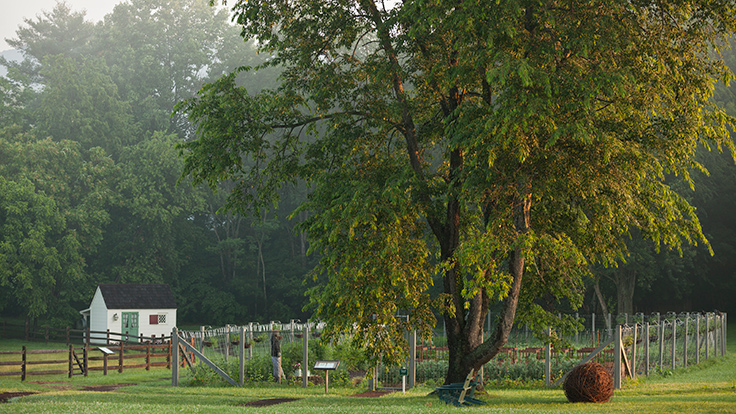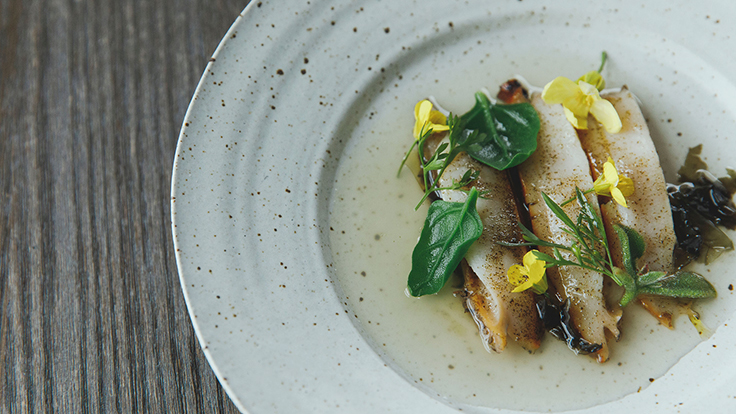A MICHELIN Star is awarded for outstanding cooking, but a MICHELIN Green Star is awarded to restaurants that are highly sustainable—working with local farmers, growers, and fishers, utilizing seasonal ingredients, avoiding waste, reducing or removing entirely single-use plastics, and generally working to have a lower environmental impact. For UN Sustainable Gastronomy Day and every day, 11 MICHELIN Green Star restaurants where being kind to the environment is as important as the food.
New York
Blue Hill at Stone Barns
Stone Barns Center for Food and Agriculture sets the national conversation for healthy and sustainable food systems. Chef/co-owner Dan Barber asked, "How could we support the bottom line of small, independent farms? What exactly did a menu that delivers on the economic viability of farmers and the ecological viability of their farm look like?" These question carry onto the bone ash china gracing the tables and kitchen scraps transformed into charcoal. Meals begin with an onslaught of clever bites, mostly vegetables plucked from the property's greenhouses and farm. The kitchen infuses even the most unlikely ingredients—sourced from 60+ local farmers—with magic, like zesty green gazpacho paired with surf clam and radicchio; or dry-aged golden beet "steak" adorned with beef-studded jus.
Washington, DC
The Inn at Little Washington
Embellished to the very last inch, this dining room resembles a jewel box lined with patterned carpets, lush wallpaper, and shimmering fabrics. The Inn has been serving regional American cuisine utilizing indigenous products from local farmers, ranchers, and the Inn's own garden for 43 years. Chef-owner Patrick O'Connell says, "The importance of conscientious stewardship for our surrounding land of Rappahannock County adjacent to Shenandoah National park has become a strong movement. Our staff is working diligently on reducing plastic consumption and recycling and we continue to enhance our practices daily." Each menu has a unique focus, as in the “Gastronaut" and “The Good Earth” offering superb vegetarian items. Sauces work a particular magic, as evidenced by the truffle-infused tartar with morel “crabcake.”
Los Angeles
Osteria Mozza
This Hollywood darling pleases with creative cocktails and delicious Italian cuisine while upholding chef-owner Nancy Silverton's commitment to sustainability. There are low-flow faucets in the bathroom and kitchen prep sinks, to conserve water in a draught-prone state. “We’ve always been very, very conscientious as to the purchasing of our vegetables and proteins, to make sure we understood how they were grown and who we were buying from,” Silverton says. The team here strives to show you around the corners of Italian cooking, so dive right in to the calf’s brain ravioli with burro e limone. The crispy chicken leg is pure and simple comfort food; and pastas are unsurprisingly phenomenal—try the orecchiette with sausage and Swiss chard.Chi Spacca
The carnivorous heart of Nancy Silverton’s “Mozzaplex” aims to uphold the same sustainability standards as Osteria Mozza. It's intimate, engaging, and expensive—a place to splurge on date night with a special vintage and view of the bustling wood-fired oven and grill. The result is a modern Italian take on the old-school steakhouse, with the focaccia di recco and bistecca alla Fiorentina being some of their key indulgences.
Northern California
The French Laundry — Yountville
Thomas Keller’s legendary destination doesn’t miss a beat. The cuisine, staff and state-of-the-art kitchen embedded with the chef's renowned sense of purpose and sustainability remain at their pinnacle. This approach has resulted in a curated network of suppliers who share the same reverence for the environment and a restaurant whose structure and water filtration system are designed to reduced carbon emissions. Chef Keller and his team pair classic French techniques with highly local, seasonal ingredients. Dinner may bring signature oysters with white sturgeon caviar in a warm sabayon studded with tapioca pearls, or Pacific shima aji tartare composed with puffed grains for texture and a vibrant tomato and jalapeño "chiffon" for (immense) flavor. "Coffee and Donuts" along with a box of handmade chocolates ends the experience on a sweet note.

SingleThread — Healdsburg
Exquisite barely begins to describe a meal at this Healdsburg jewel, where spring might bring delicately smoked Ora king salmon topped with arctic char roe and myoga and winter showcases pumpkin tartare with Dungeness crab and a miso-makrut lime foam. The menu is acutely tuned to each micro-season in Sonoma County, thanks to the bounty provided by farmer and co-owner Katina Connaughton. Connaughton's farm is an organic, no-till farm, a regenerative practice that enhances the ability of soil to sequester carbon (thus reducing greenhouse gases in the environment); it provides 70% of the restaurant's produce, and the remaining 30% come from Sonoma Valley suppliers.
Harbor House — Elk
This crowning dining room is perched on a bluff, surrounded by craggy cliffs, the crashing Pacific, and a spectacular sunset. This is cooking that is highly original, driven by impeccable technique and devotion to sustainability. Chef Matthew Kammerer is devout when it comes to hyper-local and foraged ingredients; his efforts include utilizing produce sourced from their organic farm, hydrated with the restaurant's gray water. Rather than relying on delivery trucks, the team forages for seaweed in nearby tidepools, along with mushrooms, edible weeds and other low-impact ingredients. Bread service includes slices of fantastic sourdough, flecked with seaweed. Then, seaweed may return in the form of ice cream with bay nut, quince, and shiso—flaunting an ingenious union of sweet and savory tastes.
Chez Panisse — Berkeley
Farm-to-table dining has spread far and wide, but credit Chez Panisse and chef-owner Alice Waters with birthing the farm-to-table movement in America. Since 1971, the restaurant hasn’t wavered in its dedication to serving nothing but California’s bounty on a plate (all produce is sourced from a 50-mile radius). Moving beyond words like local and in-season, Chez Panisse has become a proponent of the “slow food” movement that requires regenerative methods of growing, raising and cultivating ingredients. For Waters, it isn’t simply a matter of superior taste, but an obligation to future generations. Diners here are privy to one nightly fixed menu of four rotating courses starring peak-season produce—from fresh peas, asparagus and black truffle in a spring risotto, to sweet corn and squash blossoms served with a summer preparation of pork loin.
Atelier Crenn — San Francisco
At the hands of accomplished Chef Dominique Crenn, guests have rightly come to expect a thrilling meal. Another exclusive hallmark of dining here is a deep commitment to sustainability. Bleu Belle Farms in Sonoma county, a four-acre plot of land 45 miles from the city, supplies the restaurant with a majority of its produce. Farmer William Henpenn uses biodynamic methods to grow fruits and vegetables that can be the stars of the plate, not just flourishes on the side. Food scraps and other compostable items are sent back to Bleu Belle Farms to nourish the soil. Expect caviar crowned by turbot gelée and gold leaf and spiny lobster with dots of apple butter and a warm ginger-whey foam—a wondrous creation brimming with flavor and depth. Pastry chef/partner Juan Contreras’ snowflake dessert, subtly redolent of eucalyptus, is a delicate iced invention that is as much a conversation piece as it is confection.
Bar Crenn — San Francisco
Like its sister next door, Bar Crenn adheres to the same sustainability tenets. Designed with an eye on Paris during Les Années Folles with a splash of speakeasy, this room is a flea market-chic amalgam of lounge furniture, glinting chandeliers and vintage accents. The classic French cooking strives to recreate many of the century’s great dishes, but the concise menu evolves with the seasons—think Fleur de Courgettes Farcies, a squash blossom filled with ground spot prawn, or the tarte a la tomate with a delicate, golden-brown crust filled with parmesan custard and topped with red and golden cherry tomatoes. 
Quince — San Francisco
Lindsay and Michael Tusk source their produce from Fresh Run Farm in Bolinas, one of the oldest certified organic farms in the country. The menu at Quince is an extension of each season’s harvest. The kitchen sends food scraps back to Fresh River Farm where it is transformed into nourishing compost for the next season’s harvest. A beautiful glass vessel with golden osetra caviar is set atop a delicate oyster panna cotta makes a deliciously high-brow starter. This may be tailed by a special plate of tortellini, which when filled with pork, parmesan and tossed in beurre blanc, forms the very picture of delicacy. Venison coated with vegetable crumbs and enriched by potato purée, quince and chestnut makes for a particularly delightful entrée.
Hero image: Harbor House chef Matthew Kammerer tidepooling along the Elk coast. Photo by Joe Weaver



















